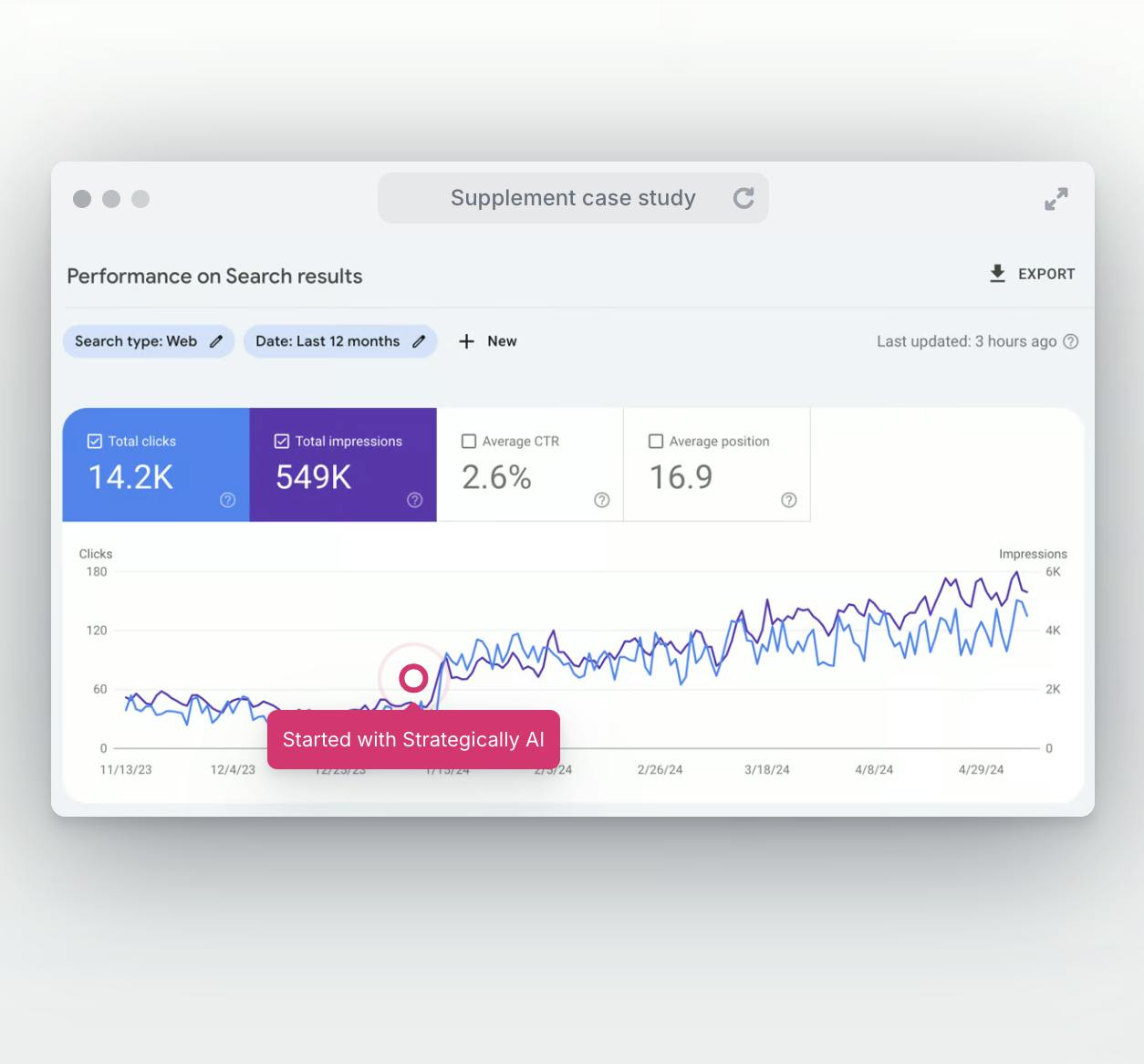Today, I’m going to show exactly how to SEO optimize your enterprise eCommerce site.
In fact, these are the exact strategies we used these strategies to take a client’s site from 1023 to 5000+ clicks per day in less than four months.
So, if you want to get more organic traffic and reduce your cost per acquisition, you’ll love this new guide.
What is SEO for enterprise eComs—and why should you care?
With extensive product inventories, numerous categories, and hundreds of thousands of URLs, enterprise eCommerce stores face unique SEO challenges.
The sheer scale of some eCommerce sites can cause issues such as inefficient crawling, duplicate content, poorly optimized category pages, and important product URLs getting lost in the index.
Knowing what to do can be overwhelming, and with a large site on your hands, it’s impossible to address everything in one go. The key is identifying priorities and making informed, data-centric decisions.
For a large eCommerce site, this may involve:
- Optimizing category pages to enhance user journeys to your product pages
- Enhancing your SKU pages with review schema
- Conducting an entire site architecture re-haul to address fundamental crawling and indexing problems across the site.
Like most things worth doing, there’s no one-size-fits-all solution for enterprise eCommerce SEO; each site will have its own set of challenges, but this guide aims to provide an in-depth guide to the basics of SEO for every large-scale ecommerce site.
Ready? Let’s go.
Collection pages
If you’re not optimizing your collection pages, you are leaving money on the table. Buyers at the start of their journey are much more likely to use category-related keywords rather than specific product names, meaning your category pages serve as the entry point to your product database.
Let’s start with an example:
Buyer A, a mom, is starting to search for shoes for her son's school. She's been given the school uniform list and knows she needs to get black shoes. However, as she doesn't have any more information to start with, she begins her search for “black school shoes” and are presented with page one of Google displaying collection pages like this:

Of course, later in the buying journey, once she’s done some more research, the mom may start searching for “matt leather black school shoes size 5 less than $50”. However, that’s only once she’s narrowed down her search by reviewing the collection pages and getting a better idea of what suits her son's needs.
The collection page targets the buyer at the start of their journey when they are researching and comparing, and it drives traffic to the product page when they’re ready to buy. In other words, if you don’t optimize your collection pages to attract these users in the search engine results pages (SERP), you may as well hand the cash straight to your competitor.
But before you dive headfirst into collection page optimizations, you need to determine which pages to optimize. So, the first step is keyword research and competitor analysis to make sure your category and subcategory pages align with what your potential customers are searching for.
To do so, go to Strategically AI. With Strategically AI, you can cluster keywords for topics or collection pages from competitive analysis or a list of seed keywords. To do either option, head over to the Keyword Explorer tab on the left-hand menu.

Once inside the Keyword Explorer, choose the analysis type. We’ll cover the process for using a CSV of seed keywords, but the process is exactly the same, except for the first step, if you choose to go with a competitor analysis instead.

You can upload a CSV of any keywords you would like. The keywords don’t need to be related to each other; Strategically, AI will sort this out during the analysis phase. Hit Explore Keywords and wait for the keywords to be uploaded to the system.
Once the upload has been completed, head over to the Keyword Cluster tab on the left-hand side. Enter a project name and select the list of keywords from the drop-down.

Hit cluster keywords and wait. Strategically AI is analyzing your keywords to find relevant clusters for topics, pillars, and posts. This can take 10 - 20 minutes, but you can navigate away from the app, grab a coffee, and return later.
Once the analysis is complete, you can find your keyword clusters in your Command Center. You can view the clusters, the number of keywords per cluster, and the total search volume.

For clusters with multiple keywords, you can select View Keywords to see the primary and secondary keywords to target on the page.

The final step is to select Generate Article or Generate Collection Page, which will start the process of creating the AI content based on the cluster of keywords.
(Note: Currently, only Generate Article is available. We will be launching the Collection page generation in 2-3 weeks. Watch this space!).
The benefit of using Strategically AI is that is determines exactly what keywords to target on each page and the intent of the page, whether it’s:
- Informational intent = blog
- Commercial intent = collection pages or product pages
and then reverse-engineers the content using AI to match the intent and create a ready-to-rank article or page, ensuring your on-page SEO elements are optimized as standard.
In our experience, many enterprise eCommerce sites generate content and category pages and include thin, templated text alongside product pages and filters. However, with Google's new helpful content update, adding generic filler content can negatively impact a site's visibility. It's important to ensure that each category and subcategory has unique, user-friendly text that sets your offering apart from others.
That’s how Strategically AI helps. It works by analyzing the content currently ranking for your cluster keywords and using brand memory (a storage of information about your products and brands) Strategically AI creates valuable, personalized collection page content quickly and easily.
Finally, it’s important to ensure your category and subcategory pages are well interconnected through internal linking. In addition to links from navigation dropdowns and footers, clear links within the categories themselves should be included to guide users to related subcategories.
For example, our mom browsing the "black school shoes" category may also need to visit subcategories, such as "size 5 black school shoes" or "lace-up black school shoes" for them to explore further. Consider creating internal linking journeys to companion categories as well to guide users toward associated products, such as other school uniform categories.

Site architecture
The structure of URLs and the overall architecture of your site are extremely important for helping Google crawl and index your site effectively. If your site has poor architecture, URL navigation, or internal linking, it can cause issues with important content being overlooked by Google, among other things.
Generally, Google favors websites with a straightforward, expandable structure and easy navigation. Primary categories and subcategories should be easily accessible from the homepage, and users should be able to find their desired products within three clicks from the homepage.
See how the experts at Amazon do it. Despite having the world’s largest collection of products, within three clicks, I am where I want to be: browsing bedding.
Continuously adding subcategories and layers to your website each time a new product is introduced is not a sustainable way to manage your site structure. This approach can push your important pages deeper down the site hierarchy, making it much more difficult for Google to find and present your pages to searchers.
That’s all well and good in an ideal world, but we’ve spoken to 3000+ eCommerce stores, and we understand how challenging it is to keep your website updated in a fast-paced work environment. As websites expand, brand offerings change and inventories are constantly updated, there may be occasions where SEO considerations regarding site architecture are overlooked. We get it :)
What’s more, very few large eCommerce stores have the privilege of being able to dictate the site architecture right from the start. By the very nature of being a large eCommerce site, it’s unlikely right from the outset that you knew exactly what the site would look like down the line, so you often have to work with the site as it has grown organically over several years.
It is also not usually feasible, both technically and financially, to completely revamp your website’s architecture at any given time, except perhaps during a general rebrand. Making major changes to the URL or site structure can pose significant SEO risks if a site already has a strong presence on Google and is generating revenue, even if its structure is not optimal.
We always recommend, rather than making large-scale changes all at once, focusing on making improvements gradually as new products or pages are added, for example:
- Look for opportunities to better organize categories and sections of the site within the main hierarchy through internal linking.
- If there is keyword and conversion data supporting it, consider moving similar categories higher up in the navigation hierarchy.
- Also, consider optimizing the footer to ensure that links to all key categories can be easily found and accessed from the homepage.
- Consider creating and submitting individual sitemaps for different sections of the site to encourage search engines like Google to crawl the site more regularly.
Also, to manage extensive inventories on large eCommerce sites, you can use faceted navigation in your site structure. Faceted navigation is a popular user experience technique on big eCommerce platforms, allowing users to easily adjust different attributes to refine their search on a category page.
For example, on a clothing store's shirt category page, users can filter by price range, size, color, brand, style, and more. When a user selects filters, JavaScript reloads the page with products matching the chosen filters.

While faceted navigation is beneficial for users, it can cause some SEO challenges, such as:
- Potential duplicate content and indexing issues. A common mistake is retaining blocks of category text that do not change when a user selects certain filters and the URL changes.
- Numerous crawlable URL variables can be generated as users switch between different filters. This can result in crawl budget problems and Google prioritizing faceted URLs over your main category pages.
If you use faceted navigation, ensure that any facets you want indexed are based on keyword search demand. Conversely, you need to consider rules to prevent thousands of faceted URLs from being indexed unintentionally. You might want to consider using canonicalization strategies or adding URL parameters after a certain number of facets are selected to discourage Google from indexing them.
URL handling
Site architecture is challenging but crucial to the success of an SEO campaign for large eCommerce stores.
Pagination
If you have many products in one category, this will mean you also have many pages within the category. This usually requires users to click "next page," "view more," or page numbers to navigate through the pages of the collection. However, if not managed correctly, it can pose risks to your site's SEO visibility.

When using pagination on your website, there's a risk that Google may mistakenly think you only have one page of results in a category, even if you have thousands. This can damage your authority in that category and make it harder for unique pages within the pagination sequence to be crawled and indexed.
Here are a few do’s and don’ts of pagination in large eCommerce sites:
Do:
✅ Make it easier for Google to find these paginated pages by using self-canonicalization and implementing clear internal linking.
✅ Add introductory text only on the main page and exclude paginated pages from XML sitemaps to avoid duplicate content issues and prevent incorrect paginated URLs from appearing in search results.
✅ Have your website gradually load content based on user interactions to enhance user experience.
✅ Help search engines understand the relationship between pages of paginated content, including links from each page to the next using <a href> tags.
✅ Link all individual pages in a collection back to the first page to show Google that it might be a better landing page.
✅ Give each page a unique URL. For example, include a ?page=n query parameter, as Google treats URLs in a paginated sequence as separate pages.
✅ Consider using preload, preconnect, or prefetch to optimize performance when users move to the next page.
Don’t:
❌ Remember to noindex paginated pages. This will ensure that any potential ranking signals from these pages are ignored.
❌ Canonicalizing parameter URLs to the original root is done to consolidate authority to a root page or save on the crawl budget.
❌ Don't use the first page of a paginated sequence as the canonical page. Instead, give each page in its own canonical URL.
❌ Avoid using URL fragment identifiers for page numbers in a collection as Google ignores them. If the URL to the next page only differs by the text after the #, Googlebot may not follow the link, thinking it has already retrieved the page.
❌ Avoid indexing variations of the same list of results. Block unwanted URLs from being indexed with the noindex robots meta tag or discourage crawling of particular URL patterns with a robots.txt file.
SKU product variants
In many eCommerce inventories, products may have different variants with unique features.
Let’s return to our school uniform example; for example, if you’re selling school uniforms, you're likely to have separate variant pages for each type of school sweater. This means that each sweater model may have its own unique URL, for example:
- domain.com/sweaters/jumpers-sweatshirts
Upon clicking through the “jumpers and sweatshirt” page, the user then may have the option to select a color, which in turn generates unique URLs:
Upon clicking through the “school sweatshirts” page, the user then may have the option to select a color, which in turn generates unique URLs:
- domain.com/school/jumpers-sweatshirts-blue
- domain.com/school/jumpers-sweatshirts-red
- domain.com/school/jumpers-sweatshirts-green
Or you may have a parameter in the URL, like this:
- domain.com/school/jumpers-sweatshirts?=blue
- domain.com/school/jumpers-sweatshirts?=red
- domain.com/school/jumpers-sweatshirts?=green
When managing a large website with thousands of products, each with ten to fifteen variants, there is a risk of having too many URLs and duplicate content, which can negatively impact SEO. From a management perspective, there might be a temptation to minimize this by setting all variant URLs to the root URL.
From a practical standpoint, this makes sense, but unless there is clear evidence that there is little-to-no keyword opportunity for certain product feature variants or little-to-no historic organic traffic to these variant URLs, then it is recommended that these product variants be indexed.
These days, users are more knowledgeable and know what they are looking for, especially as they progress along the buying journey.
For example, a search for "black leather school shoes with laces" rather than "black shoes" indicates a more advanced buyer intent that is much closer to making a purchase. You will want to ensure that you have that product variant page ready and available.
Add structured data
The product schema markup is crucial for your online shop. By adding it to each product page in your eCommerce store, you help search engines understand important information such as the product's name, price, availability, brand, image, reviews, and short descriptions.
This information will be displayed on the search engine results as rich snippets, providing customers with key details even before they click on the product page. This can help customers make more informed decisions. Below, you'll find an example of the product schema markup, which also includes information on the offer and aggregate rating.

The Aggregate Rating schema displays ratings and reviews directly within the Search Engine Results Page (SERP). This helps to establish trust between the business and users, as prospective customers often rely on previous customer feedback when making purchasing decisions. The value displayed on the SERP is an average rating derived from multiple reviews.
By showcasing ratings in the SERP, businesses can entice potential customers to visit their online store's product page, ultimately boosting the product page's visibility and increasing conversions. Below is an example demonstrating the use of the Aggregate Rating markup within a Product schema and alongside the Offer schema.

Now it’s over to you.
What strategy is most important for your site?
- Do you need to update your website architecture?
- Do you need to optimize your collections pages?
You’re not alone.
Try Strategically AI for free and see how it can help you scale your eCommerce traffic and reduce your CAC.








